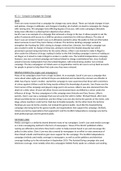AC 2.1 - Compare Campaigns for Change
AIMS
There are many reasons that a campaign for change may come about. These can include changes in laws
and policies, changes in attitudes, and changes in funding, all of which can lead to campaigns for change
with varying aims. All campaigns have differing degrees of success, with some campaigns ultimately
being more effective in achieving their objectives than others.
Sarah’s Law is an example of a campaign that achieved a change in the law. It allows people to ask the
police if someone with access to a child has previous convictions for child sex offences. The aims of
Clare’s Law are similar to Sarah’s Law as it ultimately wanted to allow the public to find out information
about someone to see if they had a history of abuse. The Anti-Fox Hunting campaign wanted to
strengthen the Hunting Act 2004, aiming to change criminal law. Likewise, Ann Ming’s campaign was
also created in order to change criminal law, aiming to remove the Double Jeopardy law which
prevented a person being tried twice for the same offence. Lillian’s Law wanted to make it illegal to
drive under the influence of drugs, making it similar to the Anti-Smoking campaign in terms of making an
act illegal, as it aimed to make it illegal to smoke in a public area. The Scottish Independence campaign,
however, was not a criminal campaign and instead aimed to change constitutional law, since Scotland
aimed to become independent from the United Kingdom, with Unlock being another non-criminal
campaign. The key campaigners of Unlock were an organisation and its aim was to set up bank accounts
for people in prison to help them find a job once they were released.
DRIVING FORCES (the origins and campaigners)
Many of my campaigns arose from a tragic incident. As an example, Sarah’s Law was a campaign that
came about when eight-year-old Sarah Payne was abducted and murdered by a known sex offender in
2000. Sara Payne, Sarah’s mother, started the campaign to raise awareness that those with convictions
of crimes against children could be living nearby without the knowledge of parents. Sara Payne was the
front runner of the campaign and played a large part in its success. Lillian’s Law also stemmed from the
death of a child, when 14-year-old Lillian Groves was knocked down and killed by a driver under the
influence of drugs. The key campaigners in this campaign were Natasha and Gary Groves, Lillian’s
parents. Clare’s Law was a campaign that was set up by the victim’s father, Michael Wood, after Clare
Wood was killed by her ex-boyfriend, and Ann Ming’s Law was also led by the parents of the victim, Julie
Hogg, whose murderer could not be tried due to Double Jeopardy. On the other hand, the Anti-Fox
Hunting Law was not led by a family, but instead the general public, much like the Assisted Dying
campaign also being led by the general public and organisations that support the campaign. Similarly,
Unlock was led by organisations that supported it and the Scottish Independence campaign was led by
both political groups and the general public.
METHODS USED
Media coverage is a similarity shared between many of my campaigns. Sarah’s Law used media coverage
as a main campaigning method in the form of newspapers. ‘News of the World’ published articles
naming sex offenders and where they lived in order to help promote Sarah’s Law and encourage the
police to take action. Clare’s Law was also covered by newspapers in an effort to raise awareness of
Clare Wood’s death and therefore gain more support for the campaign. The Scottish Independence
campaign similarly used media coverage in newspapers, as well as online petitions and television
coverage leading up to the referendum in September 2014. The Assisted Dying campaign also used
television coverage, most notably when key campaigner Debbie Purdy spoke on a debate surrounding





